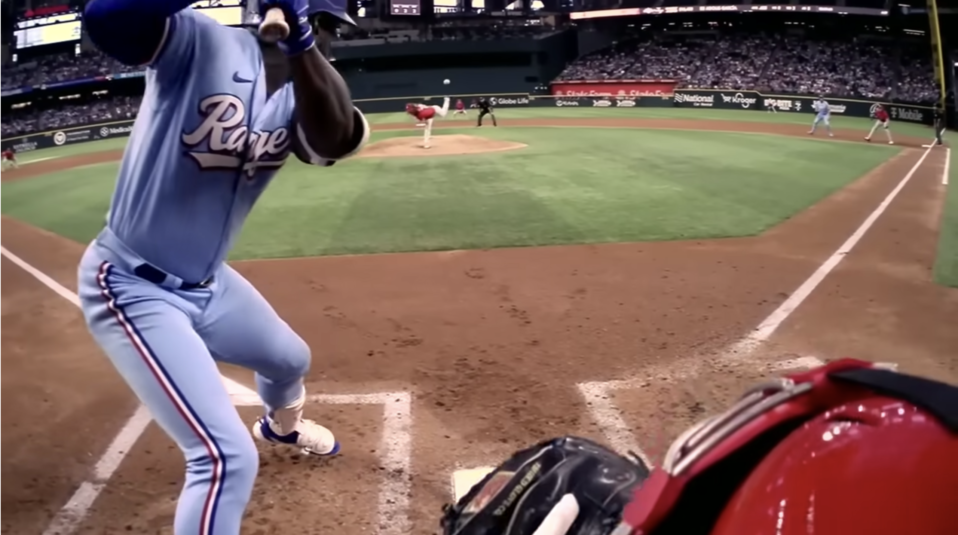Inside the Painstaking Development Process of the UmpCam With MLB and RF Wireless
The new UmpCam is being used by ESPN, Fox Sports, Apple TV for MLB broadcasts
Story Highlights
After debuting during Fox Sports’ coverage of the MLB All-Star Game last year, RF Wireless’s new UmpCam system has been popping up across broadcasts on ESPN, Fox, and Apple TV during the opening two weeks of the season. Although similar systems have been used for baseball coverage in the past – both Fox and ESPN deployed similar systems on catchers and/or umps in the early 2000s — RF Wireless’s system is the first that can be integrated into the line cut and properly shaded in the truck so that it closely matches the rest of the cameras in the broadcast.
“Our goal was to avoid any disruption of the workflow in the truck and make it as feel like it is in time with every other resource,” says RF Wireless President Rob Bunn, “while putting a device on the umpire that was light enough and small enough so that he wasn’t disrupted either.”
Three Years of Development: ‘Many, Many Rounds of Testing’
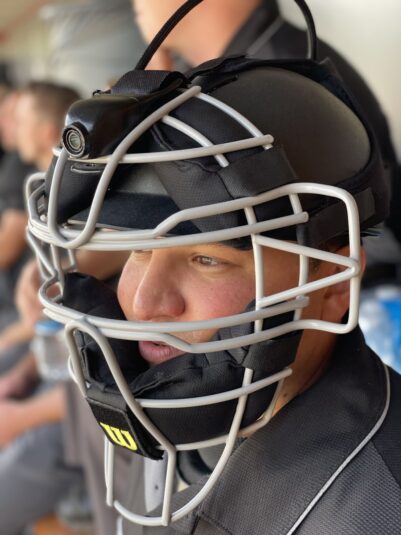 MLB and RF Wireless have been developing the system — which features a small Marshall board-level POV camera, miniaturized RF transmitter, and housing customized to the type of mask the umpire is wearing — for nearly three years. MLB first approached RF Wireless about the concept after seeing the quality of the RefCam systems thatRF Wireless had developed for NHL coverage.
MLB and RF Wireless have been developing the system — which features a small Marshall board-level POV camera, miniaturized RF transmitter, and housing customized to the type of mask the umpire is wearing — for nearly three years. MLB first approached RF Wireless about the concept after seeing the quality of the RefCam systems thatRF Wireless had developed for NHL coverage.
“MLB came directly to us and asked if we would be able to do something similar [to NHL RefCam] on the umpire,” says Bunn. “The technology was pretty much ready to go, but we had to build something that was safe for the umpire and would work in that environment without disrupting them. What followed was many, many rounds of impact testing and lab testing.
RF Wireless and MLB tested the various iterations of UmpCam during games at the University of Lowell in Massachusetts. Broadcasters Fox and ESPN also provided input and encouragement throughout the development process.
RF Wireless created a custom camera-shading system for the UmpCam in-house to ensure that it looks as similar to the other cameras in the line cut as possible.
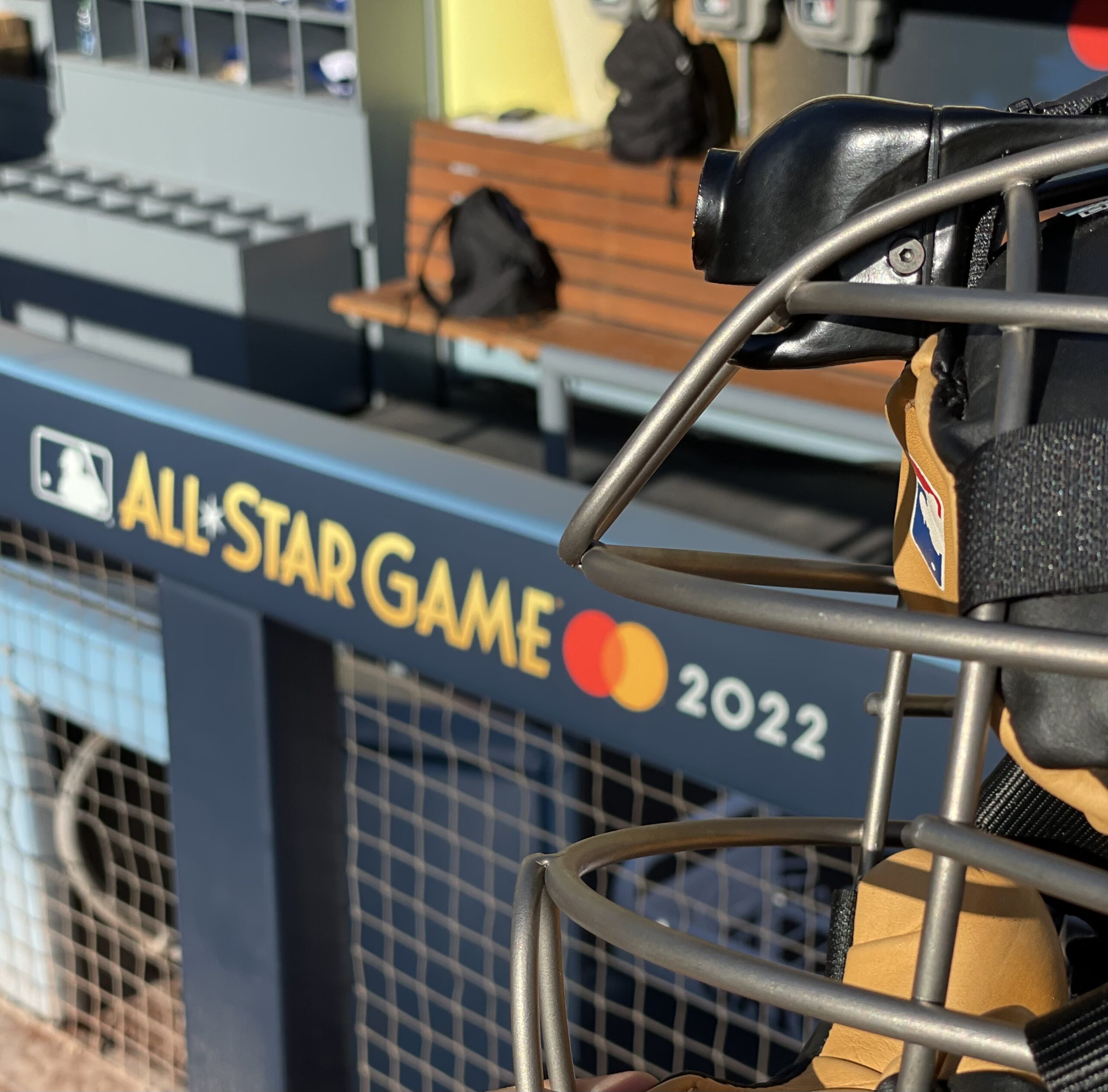
A close-up view of the positioned UmpCam
“The only way we were going to do this is if we could figure out how to paint cameras correctly,” says Bunn. “We didn’t want to just have another wearable POV camera that looked different from every other camera in the broadcast. Even though it isn’t an exact match to the [broadcast] cameras, it’s certainly a lot closer than anything else that I’ve seen.”
He adds that going with a traditional RF transmission system akin to those used on wireless handhelds, cable-based cams, and other specialty cameras allows the UmpCam feed to be timed nearly perfectly with the rest of the broadcast cameras. As a result, the UmpCam can be used in the line cut — something a few directors have already done — in addition to being used for replays.
“We spent so long developing the system,” he says, “because, if we weren’t able to match the other cameras and sync with them while also making the umpire happy, this would have been just another fad camera that lasted a few games and then disappeared.”
Going Live at MLB All-Star and Opening Night

A side view of the camera positioned on the face mask
Home-plate umpire Bill Miller was the first to wear the UmpCam during Fox’s 2022 MLB All-Star Game coverage, as well as on ESPN’s White Opening Night broadcast on March 30. He wore the mask for four innings on Opening Night, and the umpire for ESPN’s Sunday Night Baseball broadcast the following night wore it all nine innings.
“I think the real secret to success has been our ability to work directly with the umpires,” says Bunn. “We learned from hockey that this can’t just be a broadcast [tool] that we’re attaching to an umpire or ref; it needs to be something that the umpires are comfortable with, first and foremost. They need to feel like we’ve listened to them, taken their feedback, and developed it into a solution that works for them on the field.”
In terms of workflow, the broadcaster’s video techs shade the cameras themselves in the truck. An RF Wireless tech is onsite to look after the receive site and monitor all the data back and forth. A second RF Wireless tech is on the field level to change out batteries periodically throughout the game and handle any issues that might come up with the umpire or the system during the game.
“It has definitely come a long way,” says Bunn. “The first iteration looks very different from the iteration that has actually made it to the field. And we’re already working on the next iteration, which, hopefully, we can roll out next spring.”
Fox Sports on UmpCam: ‘One of the Most Significant Additions to the Broadcast’
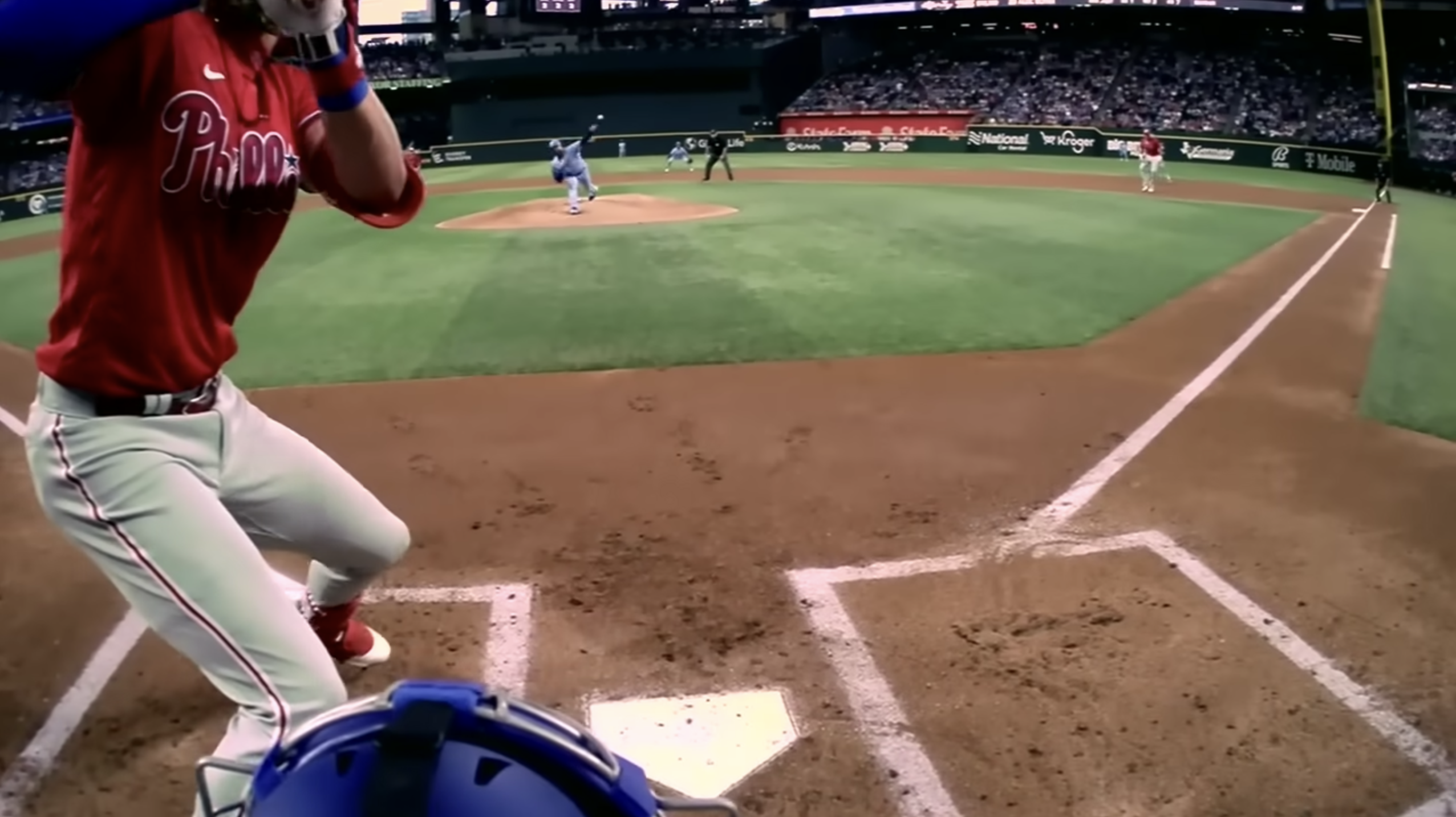
An UmpCam view of a pitch during the Phillies-Rangers game on April 2
Fox Sports SVP, Field Operations, Mike Davies says that the biggest advantage of UmpCam thus far has been on replays, where it offers a new perspective that makes a replay package much more interesting.
“We debuted the UmpCam for the All-Star Game last year,” he notes. “It was one of the most significant additions to the broadcast: not only sheer eye candy but a unique, dramatic perspective that all fans could get behind.
“The idea of the UmpCam has been something we have been chasing since CatcherCam nearly 20 years ago,” he continues. “But all credit to UmpCam’s development goes to MLB and RF Wireless, who led this iteration. They spent the time and developed the relationships to make this a reality.”
With the UmpCam, the USFL HelmetCams, and the NASCAR Drivers’ Eye system, Fox is increasingly emphasizing first-person-view cameras.
“We are looking for more ways to cover the game from the inside out,” says Davies. “We are hoping to use [UmpCam] as much as we can, to be honest; it’s a super-valuable angle that we think makes a difference in our coverage.”
ESPN on UmpCam: ‘Particularly Effective Presentation for Younger Viewers’
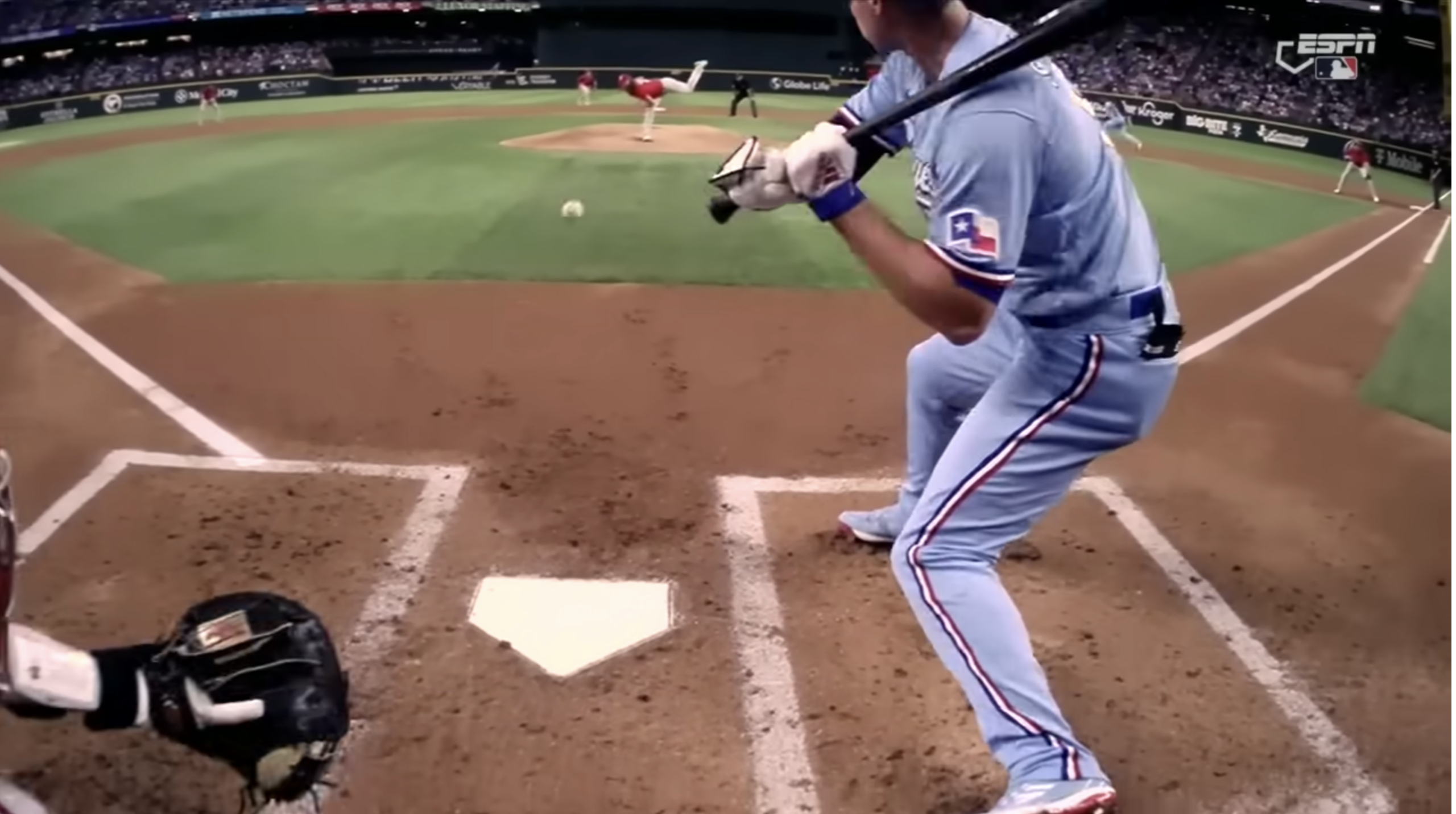
Yet another UmpCam view of a pitch during the Phillies-Rangers game on April 2
“[It has been] mostly good,” says ESPN VP, Production, Phil Orlins. “Baseball is played on a large field, with cameras forced to shoot from a substantial distance. It’s great for the viewer to be able to see the pitch from the vantage point of someone who is, by design, positioned in the perfect spot to see the pitch. We use UmpCam very aggressively for replays and are constantly evaluating how frequently we use it live. Thus far, it has been well-received. We look forward to using it a bit more aggressively live.”
During the College World Series last June, ESPN presented an UmpCam alt-cast on ESPN+ and ESPNU featuring full coverage with all the same commentary, replays, and graphics as the primary coverage. The only difference was that pitches were simply shown from UmpCam rather than from the conventional centerfield camera.
ESPN has also used this approach periodically during its KayRod Cast coverage so far this season to provide another layer of differentiation.
“We are likely to continue that approach and consider other opportunities,” says Orlins. “We believe it is a particularly effective presentation for younger viewers.”
Looking Ahead: Fox, ESPN, Apple TV Are All on Board
In terms of future deployments, ESPN is looking to use the UmpCam on at least 15 Sunday Night Baseball games this season, Fox plans to deploy it as often as possible on its MLB broadcasts, and Apple TV will feature it on the majority of its Friday Night Baseball broadcasts (which are produced by MLB Network). The deployment for each game will depend on the umpire’s willingness to wear the UmpCam, approval from MLB operations, and whether RF Wireless has the appropriate housing for the particular mask. RF Wireless’s Bunn says his team now two housings that cover about 90% of the masks used by umpires today.
“I’m really proud of my team for sticking with it and overcoming all the challenges along the way,” he says. “It has been an amazing effort between RF Wireless, MLB, and the various broadcasters, and we’re excited to be supporting them moving forward now that everyone wants to use it. We have a whole new challenge of keeping up with the demand. We’re scrambling to find technicians and build more units to get online, which is a good problem to have, for sure.”
